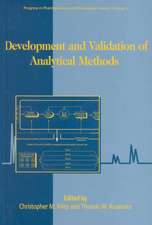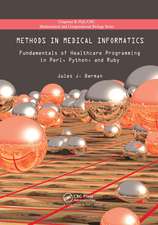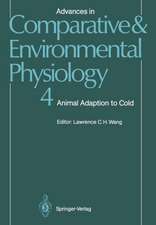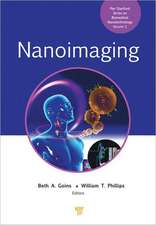Molecular Mechanisms of Metabolic Arrest: Life in Limbo: Society for Experimental Biology
Editat de K. B. Storeyen Limba Engleză Hardback – 15 iun 2001
Preț: 1223.61 lei
Preț vechi: 1492.21 lei
-18% Nou
Puncte Express: 1835
Preț estimativ în valută:
234.25€ • 244.41$ • 196.36£
234.25€ • 244.41$ • 196.36£
Carte tipărită la comandă
Livrare economică 13-27 martie
Preluare comenzi: 021 569.72.76
Specificații
ISBN-13: 9781859962121
ISBN-10: 1859962122
Pagini: 216
Dimensiuni: 156 x 234 x 17 mm
Greutate: 0.61 kg
Ediția:1
Editura: CRC Press
Colecția Garland Science
Seria Society for Experimental Biology
ISBN-10: 1859962122
Pagini: 216
Dimensiuni: 156 x 234 x 17 mm
Greutate: 0.61 kg
Ediția:1
Editura: CRC Press
Colecția Garland Science
Seria Society for Experimental Biology
Public țintă
ProfessionalCuprins
TURNING DOWN THE FIRES FOF LIFE: METABOLIC REGULATION OF HIBERNATION AND ESTIVATION. Introduction. Reversible phosphorylation and enzyme control. Signal transduction. Protein adaptation. Genes and hypometabolism. Conclusions. References. HIBERNATION, A STATE OF NATURAL TOLERANCE TO PROFOUND REDUCTION IN ORGAN BLOOD FLOW AND OXYGEN DELIVERY CAPACITY. Introduction - general features. Modulation of enzyme activity in hibernation. Hibernation induction factors. Hibernation specific factors. Adaptive changes in hibernation. Suppression of protein synthesis in brain during hibernation. Changes in gene expression during hibernation. Summary. References. THE ATP-SENSITIVE POTASSIUM CHANNEL: A METABOIC SENSOR. Introduction. The plasmalemmal K ATP channels. Conclusions. References. MITOCHONDRIAL PROTON LEAK IN METABOIC DEPRESSION. Introduction. Mitochondrial proton leak. The contribution of mitochondrial proton cycling to standard metabolic rate. The problem of mitochondrial proton cycling in metabolic depression. Proton cycling in mitochondrial isolated from metabolically depressed animals. Proton cycling in intact cells isolated metabolically depressed animals. Conclusions. References. THE HYPOXIC BRAIN: SUPRESSING ENERGY-EXPENSIVE MEMBRANE FUNCTIONS BY REGULATION OF RECEPTORS AND ION CHANNELS. Introduction. Significance. Nature of hypoxic brain injury in oxygen-sensitive brains: a brief overview. Hypoxia-tolerant vertebrate neurons. Metabolic and ion channel arrest in hypoxia-tolerant neurons: what are the targets. Electrical activity and properties of neurons from anoxia-tolerant neurons. Conclusions. References. ANOXIA SURVIVAL AND METABOLIC ARREST IN THE TURTLE. Introduction. Metabolism during anoxic submergence. Aquatic respiration in turtles. References. THERMOSTASIS IN HYPOXIC ANIMALS. Introduction. Occurrence of hypoxia-induced hypothermia. Mechanism of hypoxia-induced hypothermia. Potential mediators of hypothermia. Functional significance of hypoxia-induced hypothermia. References. CELLULAR INTERACTIONS BETWEEN RESPIRATION AND THERMOREGULATION: THE PARAMECIUM. Introduction. Thermoregulation in the paramecium. Hypoxia-induced decreases in Ts in the paramecium. Conclusion. References. COUPLING OF STRESS-INDUCED GENE EXPRESSION WITH GROWTH ARREST IN BUDDING YEAST. Introduction - the general biological context. The general stress response in budding yeast. References. TIME FOR A REST: PROGRAMMED DISPAUSE IN INSECTS. Introduction. The critical role of the brain. Diapause up-regulated genes. Diapause down-regulated genes. Gene expression associated with hormonal regulators of diapause. The gaps. References. DO STRESS PROTEINS EMBRYOS DURING METABOLIC ARREST AND DISPAUSE?. General properties and regulation of diapause. Protein folding, molecular chaperones and the small heat/shock/a-crystallin proteins. Molecular chaperones and insect diapause. Artemia diapause and p26, a small heat shock/a-crystallin protein. Perspectives and conclusion. References. MOLECULAR MECHANISMS OF DESICCATION TOLERANCE IN PLANTS. Introduction. Resurrection plants. Proteins with protective properties (LEA proteins). Activation of gene expression during dehydration: preparation for survival. Regulation of gene expression in C. plantagineum during dehydration. Perception of dehydration. Conclusions. References. INDEX.
Descriere
Molecular Mechanisms of Metabolic Arrest focuses on the latest opinions of molecular mechanisms and principles of dormancy regulation, highlighting various new concepts in metabolic rate control.































